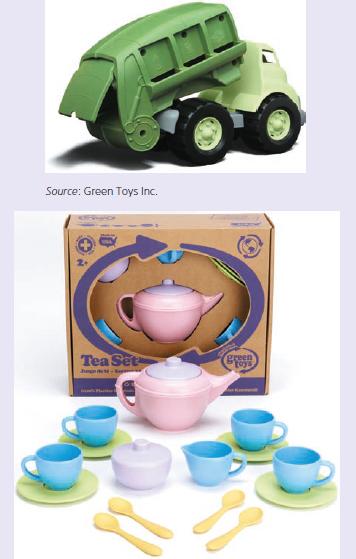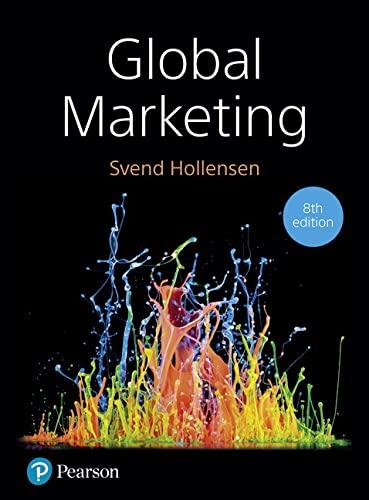In 2006, Robert von Goeben, a venture capitalist and an electronic toy designer in San Francisco, contemplated
Question:
In 2006, Robert von Goeben, a venture capitalist and an electronic toy designer in San Francisco, contemplated shifting course again. Instead of making more toys that required electricity and intricate parts, he listened to his wife and created a simpler line that would appeal to parents who identified with the green movement. More and more parents are starting to look at toys like they look at food. A toy used to be a plastic thing and parents did not question what was in it. Now green has gone mainstream, and parents want to know what is in their toys.
In August 2006, Mattel Inc. recalled more than 10 million Chinese-made toys, including the popular Barbie and Polly Pocket toys, because of lead-paint hazards and tiny magnets that could be swallowed.
The US government warned parents to make sure that children would not play with any of the recalled toys.
As questions about toy safety made more headlines in 2007 with recall of more than 17 million Chinese-made toys, von Goeben partnered with former marketing executive Laurie Hyman, a business acquaintance. Green Toys Inc. was profitable from its first year on.
Together Robert von Goeben and Laurie Hyman founded Green Toys Inc. and started right away with manufacturing of eco toys from recycled plastic milk jugs.
In November 2013 the private investment firm, The Friend Group (represented by the businessman Howard Friend), bought a majority stake in Green Toys Inc. but Von Goeben and Hyman continued their duties.
The founders of Green Toys Inc.
The two co-founders of Green Toys – Robert von Goeben (responsible for product) and Laurie Hyman (responsible for marketing) – have different backgrounds and competences:
• Robert von Goeben was the founder of Propellerhead Studios, a leading Silicon Valley design studio specializing in electronic toys and games.
At Propellerhead Studios, he worked with many major toy companies, including Mattel and Wild Planet. Before that, he was the founder and managing director of Starter Fluid, a seed-stage venture capital fund backed by institutional and corporate investors, including Compaq computers and the University of Chicago. Von Goeben’s career began in the entertainment industry where he started and managed the online division of Geffen Records. He has an MBA from the University of Southern California and a BA in Mathematics from the State University of New York.
He holds two US patents in the field of toys and games.
• Laurie Hyman used to work as a marketing executive for several online consumer-marketing companies, including, most recently, Ingenio a pioneer in combining the power of the internet and phone to connect buyers and sellers.
Before that, she was the first member of the marketing team at Webvan, where she managed relationships with some of the world’s largest consumer packaged goods companies, including P&G, Nestlé, Coca-Cola, Kraft, General Mills and Pillsbury. Hyman also served as the director of marketing at Goodcompany.com, one of the internet’s first online social networks.
She has an MBA from the University of Southern California and a BA in Business from Indiana University.
Green Toys Inc. today Green Toys Inc. makes a line of classic children’s toys constructed from recycled plastic and other environmentally friendly materials. This helps

reduce fossil fuel use and greenhouse gas emissions, improving the overall health of the planet. In 2018, the company had a turnover of approximately US$8 million. The average number of employees was 20.
Unlike its half-dozen eco-friendly competitors that manufacture or buy raw materials for their toys overseas, Green Toys contracts only with companies in California. Sourcing locally means burning less fossil fuel and creating or maintaining more US jobs. Green Toys can also track the chemical content of toys better than its counterparts.
Green Toys’ customers and marketing strategy Green Toys’ key customer segment consists of parents between the ages of 25 and 40, and they are predominantly female. The largest part of these mothers is well-educated and online. The whole world of bloggers, especially parents who are blogging and searching online about products and trends for their children, is huge.
Green Toys’ products are about 30 per cent more expensive than similar toys from major players.
Green Toys should be able to narrow that price difference by at least two-thirds as the company grows and it can utilize ‘economies of scale’, though it is unclear how popular its market segment will become. In 2018 eco-friendly toys generated just US$60 million in sales, a fraction of the US$25 billion for the US toy industry as a whole.
Green Toys’ products are sold in 3,000 US stores, including Pottery Barn, Barnes & Noble, Whole Food and Buy Buy Baby. Some of the biggest Green Toys retailers are also selling online. Consequently, the majority of the Green Toys’ marketing budget is spent online........
Questions
1. What are the key success factors in the world toy industry?
2. What are Green Toys’ key competitive advantages in the international toy market?
3. Should Green Toys Inc. consider a higher degree of international expansion of their products?
4. If yes, which countries/regions should they target and how?
Step by Step Answer:






